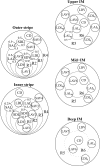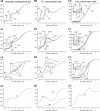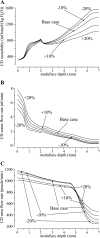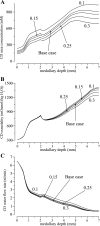A mathematical model of the urine concentrating mechanism in the rat renal medulla. I. Formulation and base-case results
- PMID: 21068086
- PMCID: PMC3044010
- DOI: 10.1152/ajprenal.00203.2010
A mathematical model of the urine concentrating mechanism in the rat renal medulla. I. Formulation and base-case results
Abstract
A new, region-based mathematical model of the urine concentrating mechanism of the rat renal medulla was used to investigate the significance of transport and structural properties revealed in anatomic studies. The model simulates preferential interactions among tubules and vessels by representing concentric regions that are centered on a vascular bundle in the outer medulla (OM) and on a collecting duct cluster in the inner medulla (IM). Particularly noteworthy features of this model include highly urea-permeable and water-impermeable segments of the long descending limbs and highly urea-permeable ascending thin limbs. Indeed, this is the first detailed mathematical model of the rat urine concentrating mechanism that represents high long-loop urea permeabilities and that produces a substantial axial osmolality gradient in the IM. That axial osmolality gradient is attributable to the increasing urea concentration gradient. The model equations, which are based on conservation of solutes and water and on standard expressions for transmural transport, were solved to steady state. Model simulations predict that the interstitial NaCl and urea concentrations in adjoining regions differ substantially in the OM but not in the IM. In the OM, active NaCl transport from thick ascending limbs, at rates inferred from the physiological literature, resulted in a concentrating effect such that the intratubular fluid osmolality of the collecting duct increases ~2.5 times along the OM. As a result of the separation of urea from NaCl and the subsequent mixing of that urea and NaCl in the interstitium and vasculature of the IM, collecting duct fluid osmolality further increases by a factor of ~1.55 along the IM.
Figures






Similar articles
-
A region-based mathematical model of the urine concentrating mechanism in the rat outer medulla. I. Formulation and base-case results.Am J Physiol Renal Physiol. 2005 Dec;289(6):F1346-66. doi: 10.1152/ajprenal.00346.2003. Epub 2005 May 24. Am J Physiol Renal Physiol. 2005. PMID: 15914776
-
A mathematical model of the urine concentrating mechanism in the rat renal medulla. II. Functional implications of three-dimensional architecture.Am J Physiol Renal Physiol. 2011 Feb;300(2):F372-84. doi: 10.1152/ajprenal.00204.2010. Epub 2010 Nov 10. Am J Physiol Renal Physiol. 2011. PMID: 21068088 Free PMC article.
-
Urine concentrating mechanism: impact of vascular and tubular architecture and a proposed descending limb urea-Na+ cotransporter.Am J Physiol Renal Physiol. 2012 Mar 1;302(5):F591-605. doi: 10.1152/ajprenal.00263.2011. Epub 2011 Nov 16. Am J Physiol Renal Physiol. 2012. PMID: 22088433 Free PMC article.
-
Role of three-dimensional architecture in the urine concentrating mechanism of the rat renal inner medulla.Am J Physiol Renal Physiol. 2008 Nov;295(5):F1271-85. doi: 10.1152/ajprenal.90252.2008. Epub 2008 May 21. Am J Physiol Renal Physiol. 2008. PMID: 18495796 Free PMC article. Review.
-
The renal concentrating mechanism: micropuncture studies of the renal medulla.Fed Proc. 1983 May 15;42(8):2392-7. Fed Proc. 1983. PMID: 6341087 Review.
Cited by
-
Isolated interstitial nodal spaces may facilitate preferential solute and fluid mixing in the rat renal inner medulla.Am J Physiol Renal Physiol. 2012 Apr 1;302(7):F830-9. doi: 10.1152/ajprenal.00539.2011. Epub 2011 Dec 7. Am J Physiol Renal Physiol. 2012. PMID: 22160770 Free PMC article.
-
Comparative physiology and architecture associated with the mammalian urine concentrating mechanism: role of inner medullary water and urea transport pathways in the rodent medulla.Am J Physiol Regul Integr Comp Physiol. 2013 Apr 1;304(7):R488-503. doi: 10.1152/ajpregu.00456.2012. Epub 2013 Jan 30. Am J Physiol Regul Integr Comp Physiol. 2013. PMID: 23364530 Free PMC article. Review.
-
Individualized treatment strategies for hyperuricemia informed by a semi-mechanistic exposure-response model of uric acid dynamics.Physiol Rep. 2018 Mar;6(5):e13614. doi: 10.14814/phy2.13614. Physiol Rep. 2018. PMID: 29488355 Free PMC article.
-
SGLT2 inhibition in a kidney with reduced nephron number: modeling and analysis of solute transport and metabolism.Am J Physiol Renal Physiol. 2018 May 1;314(5):F969-F984. doi: 10.1152/ajprenal.00551.2017. Epub 2018 Jan 17. Am J Physiol Renal Physiol. 2018. PMID: 29361669 Free PMC article.
-
Modeling glucose metabolism and lactate production in the kidney.Math Biosci. 2017 Jul;289:116-129. doi: 10.1016/j.mbs.2017.04.008. Epub 2017 May 8. Math Biosci. 2017. PMID: 28495544 Free PMC article.
References
-
- Armsen T, Reinhardt HW. Transtubular movement of urea at different degrees of water diuresis.Pflügers Arch 326:270–280, 1971 - PubMed
-
- Bankir L, de Rouffignac C. Urinary concentrating ability: insights from comparative anatomy.Am J Physiol Regul Integr Comp Physiol 249:R643–R666, 1985 - PubMed
-
- Blount MA, Sim JH, Zhou R, Martin CF, Lu W, Sands JM, Klein JD. Expression of transporters involved in urine concentration recovers differently after cessation of lithium treatment.Am J Physiol Renal Physiol 298:F601–F608, 2010 - PMC - PubMed
-
- Chen J, Layton AT, Edwards A. A mathematical model of oxygen transport in the rat outer medulla: I. model formulation and baseline results.Am J Physiol Renal Physiol 297:F517–F536, 2009 - PMC - PubMed
-
- Chou CL, Knepper MA. In vitro perfusion of chinchilla thin limb segments: urea and NaCl permeabilities.Am J Physiol Renal Fluid Electrolyte Physiol 264:F337–F343, 1993 - PubMed
Publication types
MeSH terms
Substances
Grants and funding
LinkOut - more resources
Full Text Sources
Research Materials

